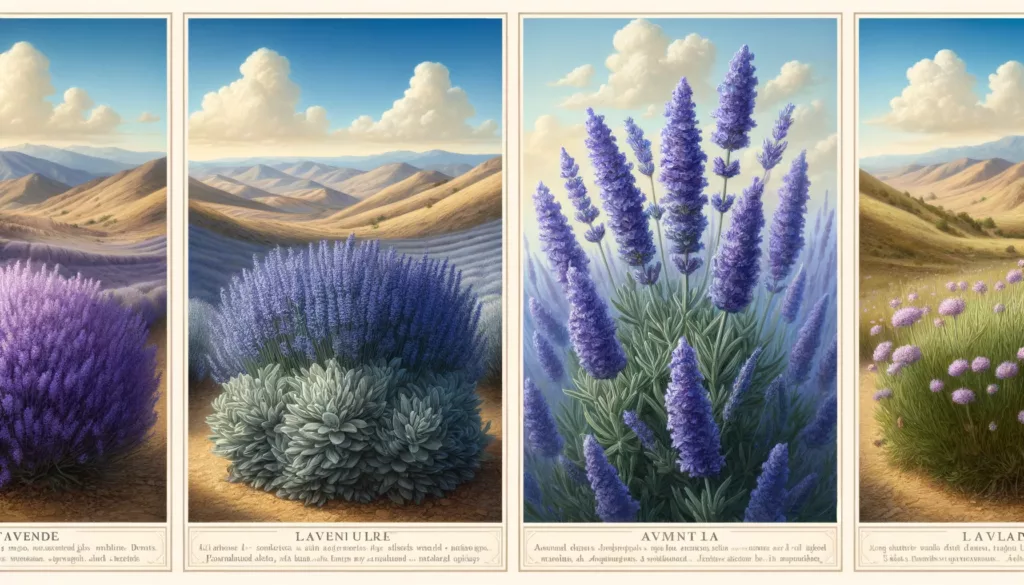
The Botanical Journey of Lavender
Geographical Origins and Evolution of Lavender Plants
Lavender, the perennial marvel of the botanical world, traces its roots to the sun-kissed hills of the Mediterranean, specifically in regions that encompass modern-day Greece, Italy, Spain, and France. This enchanting herb has flourished in these lands for millennia, a testament to its resilience and adaptability. Lavender’s journey through time is as captivating as its fragrance, revealing a plant that has evolved in harmony with the landscapes and cultures that have cherished it.
The ancient Greeks and Romans were among the first to recognize the virtues of lavender, using it to scent their baths and linens, and as a medicinal herb. The name “lavender” itself is derived from the Latin word “lavare,” meaning “to wash,” highlighting its historical association with cleanliness and purity. As lavender spread across Europe, it found a new home in the monastic gardens of medieval England, where monks cultivated it for its healing properties and aromatic delight.
Over the centuries, lavender’s cultivation expanded beyond Europe to the Americas, Australia, and Asia, each region contributing to the rich tapestry of lavender varieties we know today. This global dispersion has allowed lavender to evolve, adapting to diverse climates and soils, resulting in a myriad of species and hybrids that each tell a unique story of survival and transformation.
Different Species of Lavender and Their Distinct Scents
Lavender’s botanical family is both diverse and complex, with over 45 species and countless hybrids. Each species boasts a distinctive aroma, influenced by its genetic makeup and the environment in which it thrives. The most well-known species include Lavandula angustifolia, Lavandula latifolia, and Lavandula stoechas, each offering a unique olfactory experience.
Lavandula angustifolia, often referred to as English lavender, is prized for its sweet, floral fragrance with subtle hints of rosemary and mint. This species is renowned for its high-quality essential oil, which is widely used in aromatherapy, perfumes, and skincare products. The soothing scent of L. angustifolia is synonymous with relaxation and calm, making it a staple in wellness routines.
Lavandula latifolia, or spike lavender, presents a more robust and camphorous aroma compared to its English counterpart. The invigorating scent of L. latifolia is often employed in medicinal applications, such as in balms and salves for its purported antiseptic and anti-inflammatory properties. This species thrives in the hot, dry climates of southern Europe, where its intense fragrance fills the air during the summer months.
Lavandula stoechas, commonly known as Spanish or French lavender, is distinguished by its striking flower heads and a potent, pine-like scent. The bold fragrance of L. stoechas is less commonly used in perfumery but is appreciated in landscaping and gardening for its ornamental beauty and resilience. This species prefers rocky, well-drained soils and can often be found adorning hillsides and coastal regions.
Cultivation Techniques That Influence Fragrance Notes
The fragrance of lavender is not solely a product of its species; cultivation techniques play a crucial role in shaping the aromatic profile of this beloved herb. Factors such as soil composition, climate, and harvesting methods can significantly influence the essential oil yield and quality, making the cultivation of lavender both an art and a science.
Soil and Climate: Lavender thrives in well-drained, sandy or loamy soils with a neutral to slightly alkaline pH. The terroir, or the unique combination of soil, climate, and geography, greatly impacts the plant’s essential oil composition. For instance, lavender grown in the high altitudes of the French Alps tends to produce oil with a higher ester content, resulting in a sweeter, more refined aroma. Conversely, lavender from the Mediterranean lowlands may exhibit more pronounced camphor notes, reflecting the hotter, drier conditions.
Cultivation Practices: Sustainable farming practices, such as crop rotation and organic fertilization, contribute to the health and vigor of lavender plants, enhancing their fragrance. Careful pruning and spacing of plants ensure optimal air circulation and sunlight exposure, which are crucial for the development of aromatic compounds.
Harvesting Techniques: The timing of the harvest is a critical factor in determining the quality of lavender essential oil. Lavender is typically harvested in full bloom, when the concentration of volatile oils is at its peak. The method of harvest, whether by hand or machine, also affects the integrity of the flowers and the purity of the oil. Gentle handling and prompt processing help preserve the delicate fragrance notes that define high-quality lavender oil.
Distillation Process: The extraction of essential oil through steam distillation is a meticulous process that can influence the final scent profile. The duration and temperature of distillation, as well as the condition of the still, can alter the balance of aromatic compounds. Master distillers skillfully adjust these parameters to capture the desired fragrance, whether it be the sweet, floral essence of L. angustifolia or the sharp, invigorating aroma of L. latifolia.
Fragrance of lavender on Amazon
Conclusion
The botanical journey of lavender is a story of enduring beauty and aromatic splendor. From its ancient origins in the Mediterranean to its contemporary cultivation across the globe, lavender continues to enchant with its diverse species and captivating scents. The intricate interplay of genetics, environment, and human care ensures that each bottle of lavender essential oil carries the essence of its unique heritage, a fragrant testament to the art of cultivation and the timeless allure of this extraordinary plant.
Table summarizing the key aspects and cultivation techniques for each notable variety of lavender
| Aspect | Lavandula angustifolia (English Lavender) | Lavandula latifolia (Spike Lavender) | Lavandula stoechas (Spanish/French Lavender) |
| Origin | Mediterranean (Greece, Italy, Spain, France) | Mediterranean (Southern Europe) | Mediterranean (Spain, France) |
| Distinct Scent | Sweet, floral fragrance with hints of rosemary and mint | Robust, camphorous aroma | Potent, pine-like scent |
| Common Uses | Aromatherapy, perfumes, skincare products | Medicinal applications (balms, salves) | Ornamental gardening, landscaping |
| Preferred Soil and Climate | Well-drained, sandy/loamy soils with neutral to slightly alkaline pH; cool climates | Well-drained soils; hot, dry climates | Rocky, well-drained soils; coastal regions |
| Cultivation Practices | Sustainable farming, crop rotation, organic fertilization; careful pruning and spacing for air circulation and sunlight exposure | Sustainable practices; requires less frequent pruning due to hardiness | Sustainable practices; thrives with minimal intervention due to resilience |
| Harvesting Techniques | Harvested in full bloom for peak oil concentration; gentle handling and prompt processing | Harvested in full bloom; can tolerate machine harvesting | Harvested when flower heads are fully developed; gentle handling preferred |
| Distillation Process | Steam distillation; moderate temperature and duration to preserve sweet, floral notes | Steam distillation; higher temperature for robust, camphorous oil | Steam distillation; balanced parameters to maintain pine-like aroma |
This table highlights the origin, distinct scent, common uses, preferred soil and climate, cultivation practices, harvesting techniques, and distillation process for each notable variety of lavender.
Illustration Description

Here is a textual description illustrating the three distinct types of lavender in their natural environments:
Lavandula angustifolia (English Lavender)
Appearance: The illustration shows lush, compact bushes of Lavandula angustifolia with slender, silvery-green leaves and vibrant, violet-blue flower spikes. The flowers are densely packed, exuding a sweet, floral fragrance with hints of rosemary and mint.
Environment: This variety thrives in a well-drained, sandy soil, under a gentle sun in a cool, temperate climate. The background depicts rolling hills with a serene, blue sky dotted with soft clouds.
Lavandula latifolia (Spike Lavender)
Appearance: The Lavandula latifolia is depicted with taller, more upright spikes of pale purple flowers. The leaves are broader and the overall plant has a slightly wild, untamed look. Its robust, camphorous aroma is visually suggested by the more intense, almost medicinal appearance of the flowers.
Environment: Set in a hot, dry climate, the soil appears rocky and arid. The background shows a sun-drenched landscape with rugged terrain and sparse vegetation, typical of southern Europe.
Lavandula stoechas (Spanish/French Lavender)
Appearance: Lavandula stoechas features prominently in the illustration with its distinctive, butterfly-like flower heads in deep purple, topped with showy bracts. The leaves are green and somewhat leathery, reflecting its resilience.
Environment: This variety is shown flourishing in rocky, coastal terrain, with the sea visible in the background. The soil is depicted as rocky and well-drained, capturing the rugged beauty of its natural habitat.
Each type of lavender is labeled with its name and a short description of its scent and primary uses, enhancing the educational value of the illustration. The overall style is elegant and botanical, providing a clear and visually appealing guide to these enchanting plants.
Each illustration captures the unique appearance and environment of the different lavender varieties.
Online ressources
For those interested in cultivating lavender and exploring its diverse applications, there are numerous online resources offering detailed guides and valuable insights:
- ATTRA – Sustainable Agriculture:
This resource covers comprehensive lavender cultivation techniques, including soil requirements, climate preferences, and irrigation methods. It also discusses the different lavender varieties and their uses, particularly focusing on essential oil production and its market potential (ATTRA). - Grow Serenity:This guide provides step-by-step instructions on growing lavender from seeds or cuttings, detailing the germination process, optimal planting conditions, and care tips. It emphasizes the importance of selecting the right variety based on regional climate and offers practical advice on propagation and maintaining healthy plants (Grow Serenity).
- Agriculture Review:
This site offers a complete farming guide, including propagation methods (seeds, cuttings, layering, and tissue culture), planting techniques, spacing, and irrigation practices. It also highlights the specific needs of different lavender varieties like Lavandin and Spanish Lavender, making it a valuable resource for both small-scale gardeners and commercial farmers (Agriculture Review). - Great Lakes Lavender Farm:
A comprehensive guide on lavender care and maintenance, this resource covers essential aspects like watering, pruning, fertilizing, and pest management. It also provides insights into harvesting and the various uses of lavender, from aromatherapy to culinary applications (Great Lakes Lavender Farm). - Botanical Online:
This site details the botanical characteristics of lavender, its preferred growing conditions, and various propagation techniques. It also offers practical advice on soil preparation, fertilization, and the specific climatic requirements for optimal lavender growth (Botanical-online).
These resources collectively provide a thorough understanding of lavender cultivation practices and their applications, making them invaluable for anyone looking to successfully grow and utilize this versatile plant.
